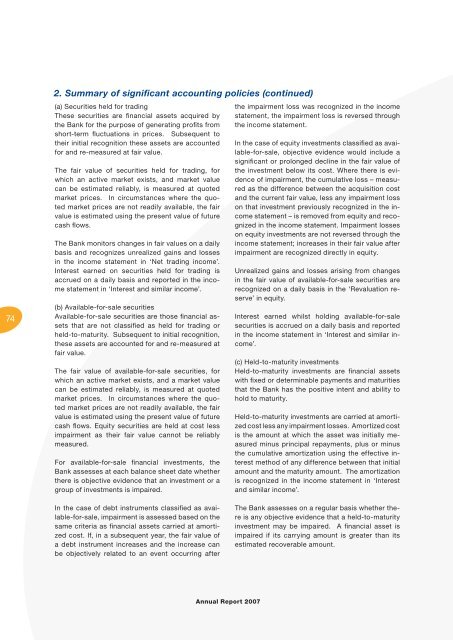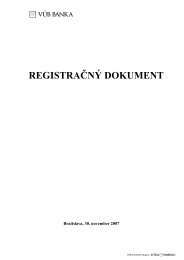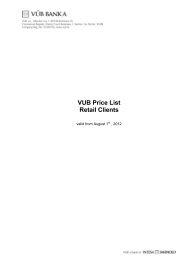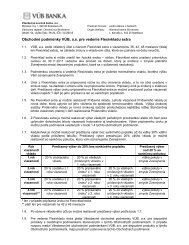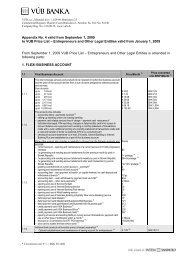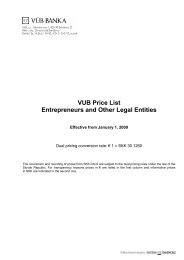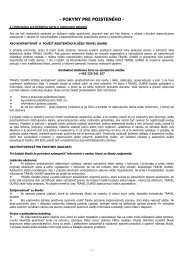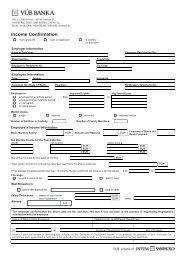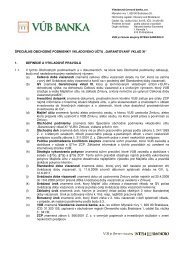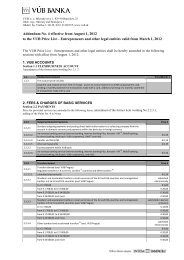Annual Report - VÃB banka
Annual Report - VÃB banka
Annual Report - VÃB banka
Create successful ePaper yourself
Turn your PDF publications into a flip-book with our unique Google optimized e-Paper software.
74<br />
2. Summary of significant accounting policies (continued)<br />
(a) Securities held for trading<br />
These securities are fi nancial assets acquired by<br />
the Bank for the purpose of generating profi ts from<br />
short-term fl uctuations in prices. Subsequent to<br />
their initial recognition these assets are accounted<br />
for and re-measured at fair value.<br />
The fair value of securities held for trading, for<br />
which an active market exists, and market value<br />
can be estimated reliably, is measured at quoted<br />
market prices. In circumstances where the quoted<br />
market prices are not readily available, the fair<br />
value is estimated using the present value of future<br />
cash fl ows.<br />
The Bank monitors changes in fair values on a daily<br />
basis and recognizes unrealized gains and losses<br />
in the income statement in ‘Net trading income’.<br />
Interest earned on securities held for trading is<br />
accrued on a daily basis and reported in the income<br />
statement in ‘Interest and similar income’.<br />
(b) Available-for-sale securities<br />
Available-for-sale securities are those fi nancial assets<br />
that are not classifi ed as held for trading or<br />
held-to-maturity. Subsequent to initial recognition,<br />
these assets are accounted for and re-measured at<br />
fair value.<br />
The fair value of available-for-sale securities, for<br />
which an active market exists, and a market value<br />
can be estimated reliably, is measured at quoted<br />
market prices. In circumstances where the quoted<br />
market prices are not readily available, the fair<br />
value is estimated using the present value of future<br />
cash fl ows. Equity securities are held at cost less<br />
impairment as their fair value cannot be reliably<br />
measured.<br />
For available-for-sale fi nancial investments, the<br />
Bank assesses at each balance sheet date whether<br />
there is objective evidence that an investment or a<br />
group of investments is impaired.<br />
the impairment loss was recognized in the income<br />
statement, the impairment loss is reversed through<br />
the income statement.<br />
In the case of equity investments classifi ed as available-for-sale,<br />
objective evidence would include a<br />
signifi cant or prolonged decline in the fair value of<br />
the investment below its cost. Where there is evidence<br />
of impairment, the cumulative loss – measured<br />
as the difference between the acquisition cost<br />
and the current fair value, less any impairment loss<br />
on that investment previously recognized in the income<br />
statement – is removed from equity and recognized<br />
in the income statement. Impairment losses<br />
on equity investments are not reversed through the<br />
income statement; increases in their fair value after<br />
impairment are recognized directly in equity.<br />
Unrealized gains and losses arising from changes<br />
in the fair value of available-for-sale securities are<br />
recognized on a daily basis in the ‘Revaluation reserve’<br />
in equity.<br />
Interest earned whilst holding available-for-sale<br />
securities is accrued on a daily basis and reported<br />
in the income statement in ‘Interest and similar income’.<br />
(c) Held-to-maturity investments<br />
Held-to-maturity investments are fi nancial assets<br />
with fi xed or determinable payments and maturities<br />
that the Bank has the positive intent and ability to<br />
hold to maturity.<br />
Held-to-maturity investments are carried at amortized<br />
cost less any impairment losses. Amortized cost<br />
is the amount at which the asset was initially measured<br />
minus principal repayments, plus or minus<br />
the cumulative amortization using the effective interest<br />
method of any difference between that initial<br />
amount and the maturity amount. The amortization<br />
is recognized in the income statement in ‘Interest<br />
and similar income’.<br />
In the case of debt instruments classifi ed as available-for-sale,<br />
impairment is assessed based on the<br />
same criteria as fi nancial assets carried at amortized<br />
cost. If, in a subsequent year, the fair value of<br />
a debt instrument increases and the increase can<br />
be objectively related to an event occurring after<br />
The Bank assesses on a regular basis whether there<br />
is any objective evidence that a held-to-maturity<br />
investment may be impaired. A fi nancial asset is<br />
impaired if its carrying amount is greater than its<br />
estimated recoverable amount.<br />
<strong>Annual</strong> <strong>Report</strong> 2007


